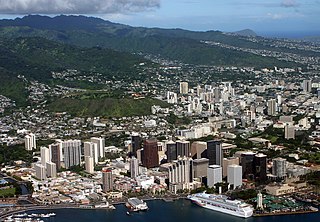 W
WThe Ala Wai Canal is an artificial waterway in Honolulu, Hawaii which serves as the northern boundary of the tourist district of Waikiki. It was created in 1928 to drain the rice paddies and swamps which would eventually become Waikiki. It also serves as a primary drainage corridor for the rivers and streams that run through central and east Honolulu.
 W
WFort DeRussy is a United States military reservation in the Waikiki area of Honolulu, Hawaii, under the jurisdiction of the United States Army. Unfenced and largely open to public traffic, the installation consists mainly of landscaped greenspace. The former Battery Randolph now houses the U.S. Army Museum of Hawaiʻi, which is open to the public. The Hale Koa Hotel, an Armed Forces Recreation Center, and the Daniel K. Inouye Asia-Pacific Center for Security Studies are also located on Fort DeRussy.
 W
WKakaʻako Waterfront Park, also known as "Point Panic Park", is a public park in Kakaʻako, south of downtown Honolulu, just off Ala Moana Boulevard at the end of Cooke Street. It was opened in November 1992 on the site of a former municipal landfill and consists of 35 acres (140,000 m2) of grass-covered rolling hills adjacent to the ocean. There is no sandy beach at this location, and access to the ocean is by concrete stairs. The park has bathrooms, water fountains, free parking, picnic tables, an amphitheatre, pay telephones, paved jogging paths, and two popular surfing spots, "Point Panic" and "Flies".
 W
WThe Kapiʻolani Community College Cactus Garden is a small botanical garden specializing in cactus. It is located on the Kapiʻolani Community College campus, near Parking Lot C, at 4303 Diamond Head Road, Honolulu, Hawaiʻi. The garden was created by Moriso Teraoka in 1988.
 W
WQueen Kapiʻolani Regional Park is the largest and second-oldest public park in Hawaii, located in Honolulu on the east end of Waikiki just beyond Kuhio Beach Park and the Waikiki residential neighborhood. The 300-acre (1.2 km2) park, named after Queen Kapiʻolani, the queen consort of King David Kalākaua, is home to the Waikiki Shell and the Honolulu Zoo.
 W
WKeaʻiwa Heiau State Recreation Area is the ruins of a temple at the summit of a hill and neighborhood called ʻAiea Heights on Oʻahu, Hawaiʻi. The recreation area includes camping facilities and a 4.8-mile (7.7 km) trail. It also offers clear views of Pearl Harbor. A possible translation of Keaʻiwa would be mysterious, incomprehensible. It is believed that this name was given in reference to the healing powers of the plants that no one could really explain. In addition, Keaiwa Heiau may have also been known as a "Heiau Hoʻola," or the healing or life-giving heiau according to Mary Kawena Pukui, a native Hawaiian scholar, dancer, composer, and educator.
 W
WKewalo Basin is a commercial boat harbor that serves as home to some of Honolulu's commercial fishing fleet, and charter and excursion vessels that serve the Hawaii tourist market. Pre-European contact, the area was historically used for human sacrifice. The land was given to Ihu by Kamehameha I and inherited by his daughter Kamakeʻe and her husband Jonah Piikoi. On the ocean side of the harbor is a small beach park on the Honolulu waterfront, located adjacent to the larger Ala Moana Beach Park. This park is good for swimming, picnicking and sightseeing. It can be accessed from the corners of Ala Moana Boulevard and Ward Avenue.
 W
WMoanalua Gardens is a 24-acre (97,000 m2) privately owned public park in Honolulu, Hawaii. The park is the site of the Kamehameha V Cottage which used to be the home of Prince Lot Kapuāiwa, who would later become King Kamehameha V. It is also the site of the annual Prince Lot Hula Festival, and the home of a large monkeypod tree that is known in Japan as the Hitachi tree.
 W
WPunchbowl Crater is an extinct volcanic tuff cone located in Honolulu, Hawaii. It is the location of the National Memorial Cemetery of the Pacific.
 W
WSand Island, formerly known as Quarantine Island, is a small island within the city of Honolulu, Hawaii, United States. The island lies at the entrance to Honolulu Harbor.